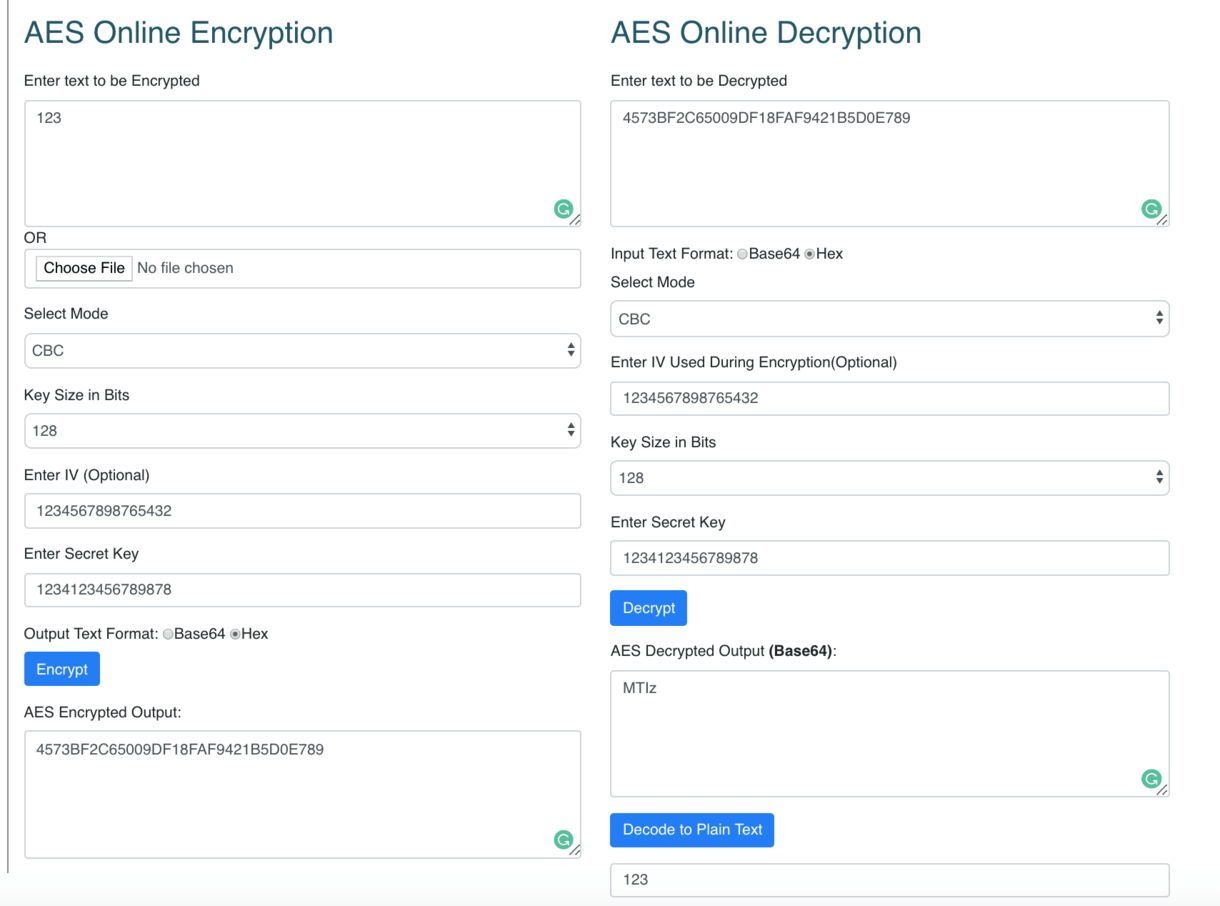Advanced Encryption Standard(AES) is a symmetric encryption
algorithm. AES is the industry standard as of now as it allows 128 bit, 192 bit and
256
bits encryption. Symmetric encryption is rapid as compared to asymmetric
encryption
and are used in systems such as database system. Following is an online tool to
perform AES
encryption and decryption of any plain-text or password.
The tool provides multiple modes of encryption and decryption such as
ECB, CBC, CTR and GCM mode.
GCM
is considered more secure than
CBC mode and is widely adopted for its performance.
For more info on AES encryption, visit this explanation
on AES Encryption.
We do not store, log any key you enter.
This tool is intended for personal and educational use.
We suggest not to use online tools to protect real production secrets.
Key Features
- Symmetric Key Algorithm: Same key is used for both encryption
and decryption.
- Block Cipher: AES operates on fixed-size blocks of data. The
standard block size is 128 bits.
- Key Lengths: AES supports key lengths of 128, 192, and 256
bits. The longer the key, the stronger the encryption.
- Security: AES is considered very secure and is widely used in
various security protocols and applications.
AES Encryption Terms & Terminologies
For encryption, you can either enter the plain text or password that you want to
encrypt. Now choose the block cipher mode of encryption.
Different Supported Modes of AES Encryption
AES offers multiple modes of encryption such as ECB, CBC, CTR, OFB, CFB and GCM
mode.
ECB(Electronic Code Book) is the simplest encryption mode and does not
require IV
for encryption. The input plain text will be divided into blocks and each block
will be
encrypted with the key provided and hence identical plain text blocks are
encrypted into
identical cipher text blocks.
CBC(Cipher Block Chaining) mode is highly recommended, and it is an advanced
form of block cipher encryption. It requires IV to make each message unique
meaning the identical
plain text blocks are encrypted into dissimilar cipher text blocks. Hence, it
provides more robust encryption as compared to ECB mode,
but it is a bit slower as compared to ECB mode. If no IV is entered then default
will be used here for CBC mode and that defaults to a
zero-based byte[16].
CTR(Counter) CTR mode (CM) is also known as integer counter mode (ICM) and
segmented integer counter (SIC) mode. Counter-mode
turns a block cipher into a stream cipher. CTR mode has similar characteristics
to OFB, but also allows a random-access property during decryption.
CTR mode is well suited to operate on a multiprocessor machine, where blocks
can be encrypted in parallel.
GCM(Galois/Counter Mode) is a
symmetric-key block cipher mode of operation that uses universal hashing to
provide authenticated encryption. GCM is considered more secure
than CBC mode because it has built-in authentication and integrity checks and is
widely used for its performance.
Padding
For AES Encryption modes CBC and ECB, the padding can be PKCS5PADDING and NoPadding.
With PKCS5Padding, a 16-byte string will produce a 32-byte output (the next multiple
of 16).
AES GCM PKCS5Padding is a synonym for NoPadding because GCM is a streaming mode that
doesn't require padding. The ciphertext in GCM is only as long as the plaintext.
Hence, nopadding
is by default selected.
AES Key Size
The AES algorithm has a 128-bit block size, regardless of whether your key length is
256, 192 or 128 bits. When a symmetric cipher mode requires an IV, the length of the
IV must
be equal to the block size of the cipher. Hence, you must always use an IV of 128
bits (16
bytes) with AES.
AES Secret Key
AES provides 128 bits, 192 bits and 256 bits of secret key size for encryption. If
you
are selecting 128 bits for encryption, then the secret key must be of 16 bits long
and 24 and 32 bits for
192 and 256 bits of key size respectively. For example, if the key size is 128, then
a
valid secret key must be of 16 characters i.e., 16*8 = 128 bits
Now you can enter the secret key accordingly. By default, the encrypted text will be
base64
encoded,
but you have options to select the output format as HEX too.
Similarly, for image and .txt file the encrypted form will be Base64 encoded.
Below is a screenshot that shows a sample usage of this online AES encryption
tool.

AES decryption has also the same process. By default, it assumes the entered text be
in
Base64 and the final decrypted output will be a plain-text string.
Support This Free Tool!
I build these tools to give you fast, secure, privacy-friendly utilities—free and
signup-free.
Buying me a coffee helps keep the project running and supports
new features.
Thank you for helping this tool thrive!
Applications of AES
- Data protection: Encrypting sensitive information.
- Secure communications: Used in SSL/TLS for secure web browsing.
- Cryptographic protocols: Employed in various security protocols
and standards such as WPA2 for wireless security.
AES is trusted for its strength and efficiency, making it a cornerstone of modern
cryptographic practices.


